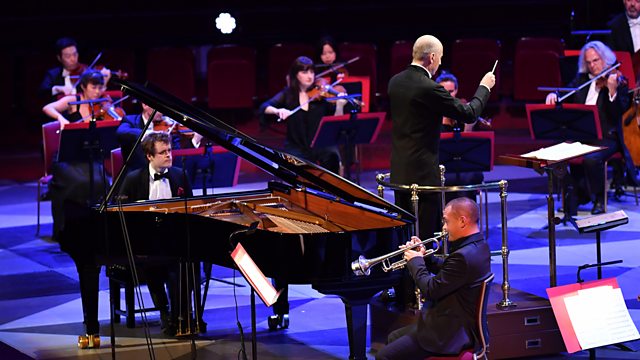
Joy and sorrow: Shostakovich's Piano Concerto and Ravel's tribute to lost friends
The Philharmonia Orchestra returns to the 91热爆 Proms with a programme of two contrasting 20th-century works.
Maurice Ravel: Le tombeau de Couperin
Dmitry Shostakovich: Concerto for piano, trumpet and strings (Piano Concerto No. 1)
Benjamin Grosvenor, piano
Jason Evans, trumpet
Philharmonia Orchestra
Paavo J盲rvi, conductor
In our second visit to the 2020 season of 91热爆 Proms, London's Philharmonia Orchestra, directed by the Estonian conductor Paavo J盲rvi, play two contrasting works. The first is a gentle tribute to both the lost world of 18th century courtly dances and to friends of the composer, Maurice Ravel, lost in the First World War. The second is the exuberant Concerto for piano, trumpet and strings by the Russian composer Dmitri Shostakovich. Two young British musicians, pianist Benjamin Grosvernor and trumpeter Jason Evans, are the soloists in the Concerto.
The French composer Maurice Ravel wrote Tombeau de Couperin, which in this context loosely translates as a Memorial to Couperin, around the time of the First World War. Francois Couperin was a leading composer of the French Baroque era of the 17th and 18th centuries and Ravel's piece originally started as a transcription of one of Couperin's dances called Forlane. That was in early 1914. Then the First World War began and things changed for music, musicians and the rest of Europe. Ravel became a truck driver at the front and the carnage he witnessed affected him deeply. So what started as a good-humoured re-working of 18th century courtly music turned into a memorial to fallen friends. For instance, the last movement of the original piano version of the Tombeau is dedicated to the musicologist Joseph de Marliave: his wife Marguerite Long gave the premiere of the piano suite in 1919. Ravel, who had unparalleled command of orchestration, later turned four of the six movements of the piano version into a symphonic work that has remained popular ever since.
Dmitry Shostakovich started his musical career as a pianist. In fact, in 1927 he was among the finalists of the Chopin piano competition in Warsaw, perhaps the most stringent of the world鈥檚 piano contests. He wrote his Concerto for piano, trumpet and strings as a vehicle to show off his pianistic skills, giving the premiere in 1933 and continuing to play it for many years afterwards. The unusual inclusion of trumpet as a second solo instrument is explained by the work's genesis: it was originally conceived as a concerto for Alexander Schmidt, the principal trumpet of the Leningrad Philharmonic, whose playing deeply impressed the composer.
The mood and form of the Concerto is far removed from the tradition of big Russian romantic concertos, such as those by Tchaikovsky or Rachmaninov. Instead, Shostakovich uses just the limited colour palette of a string orchestra and produces an ever-changing kaleidoscope of short melodies and quirky harmonies, liberally peppered with distorted quotations from other composers' works and popular tunes of the day. Shostakovich spent much of this period writing for the stage and film and also had a lot of experience of accompanying silent movies on the piano. Perhaps some of the pastiche and parody, often used in these genres, has found its way into the Concerto.
(Photo: Benjamin Grosvernor, Jason Evans, Philharmonia Orchestra and Paavo J盲rvi play Shostakovich at a 91热爆 Prom at the Royal Albert Hall in London. Credit: 91热爆/Chris Christodoulou)
Last on
More episodes
Next
You are at the last episode
Broadcasts
- Sat 12 Sep 2020 18:06GMT91热爆 World Service
- Sun 13 Sep 2020 11:06GMT91热爆 World Service
